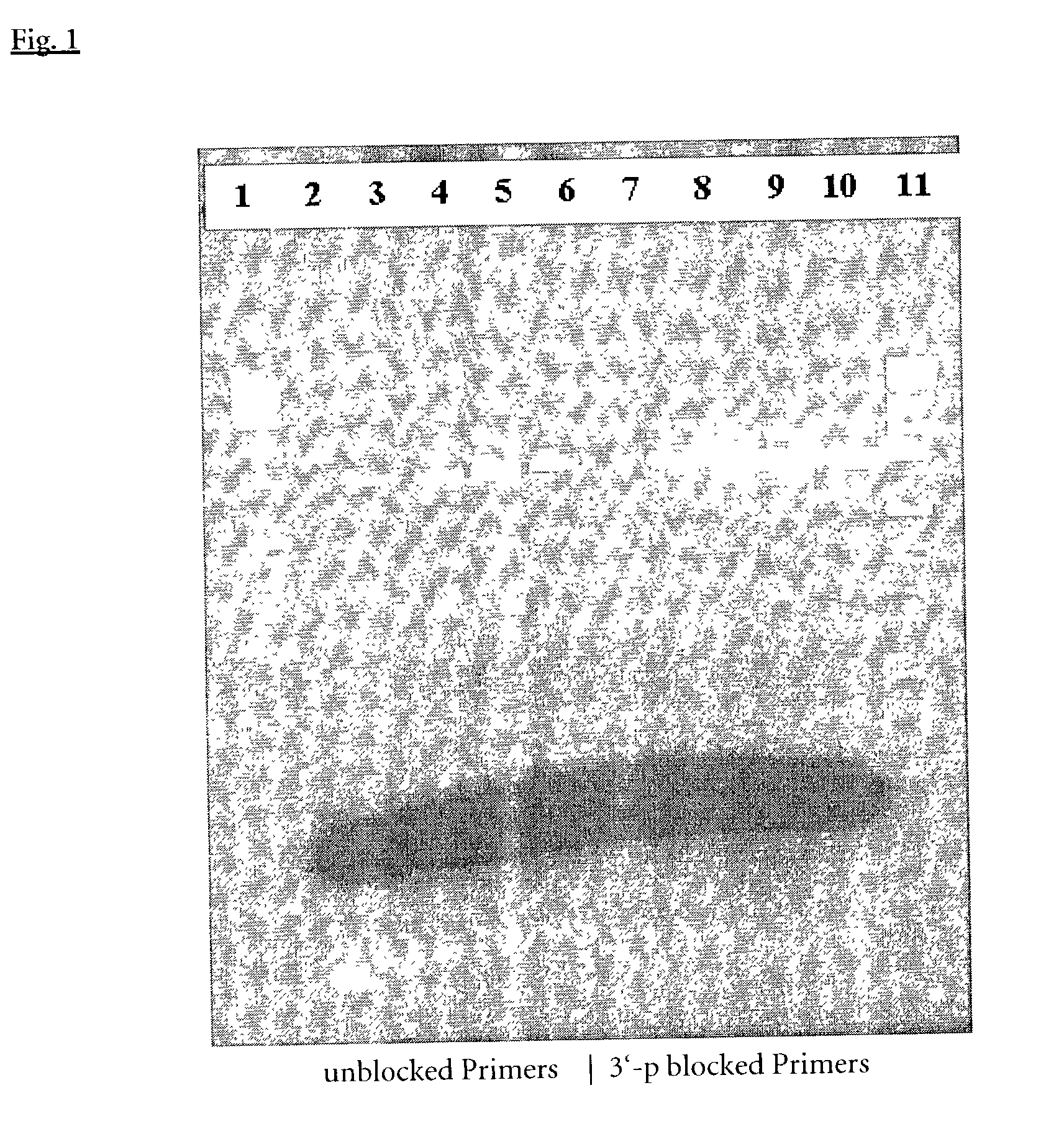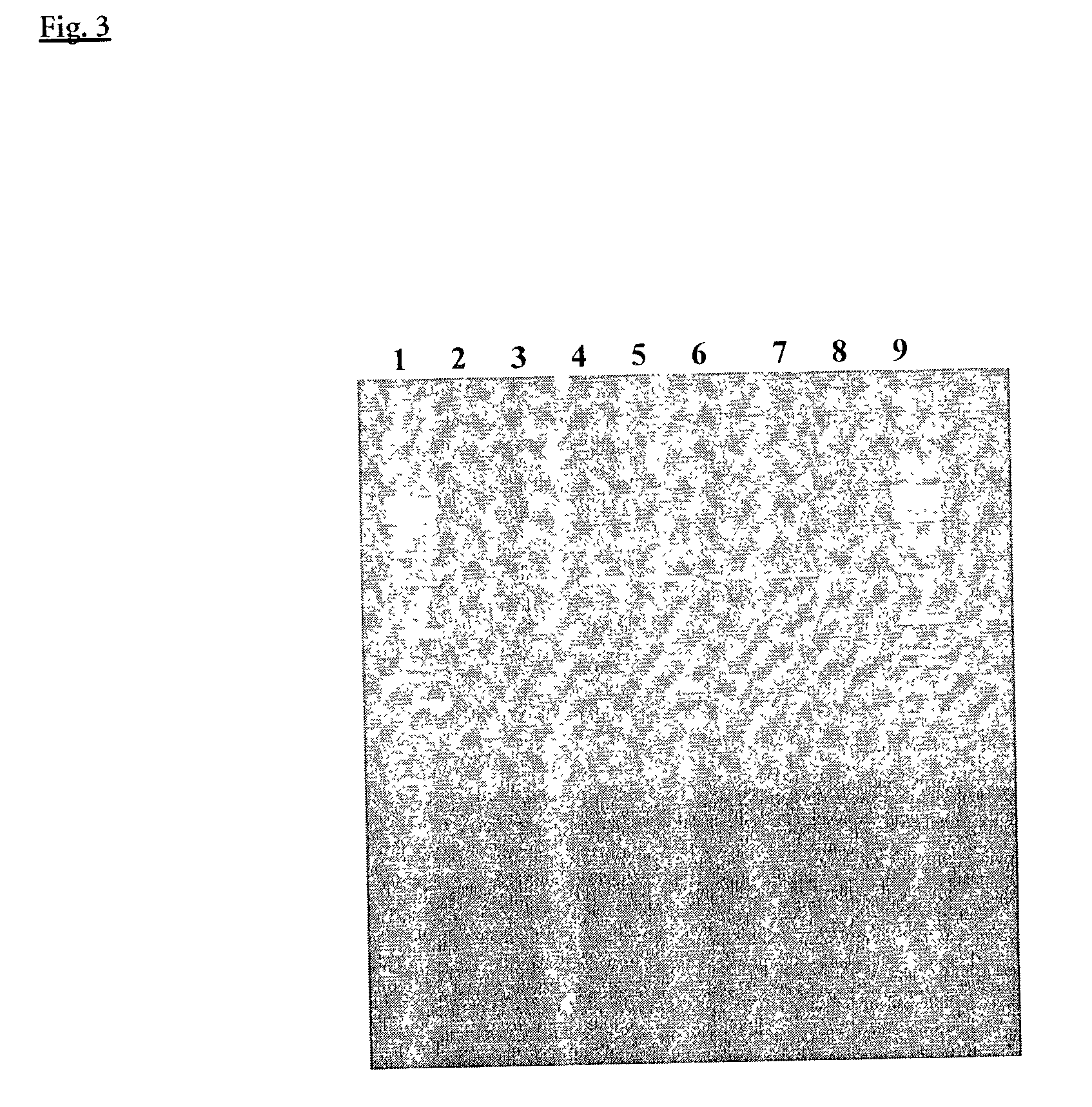Composition and method for hot start nucleic acid amplification
a nucleic acid and amplification technology, applied in the field of composition and method of hot-start nucleic acid amplification, can solve the problems of false positive, difficult cloning of amplified genes, and undesirable use in certain applications
- Summary
- Abstract
- Description
- Claims
- Application Information
AI Technical Summary
Benefits of technology
Problems solved by technology
Method used
Image
Examples
example 2
[0147] Exo-Start-PCR Induction with 3'-P-blocked Primers, Afu-Exonuclease III and Taq DNA Polymerase
[0148] PCR was performed to amplify a 2763 bp fragment from the human p53 gene using either unmodified primers according to Seq. Id. No. 1 and 2 or 3'-Phosphate-blocked primers according to Seq.Id. No. 1 and 2. Introduction of the Phosphate modification was achieved as known in the art according to example 1. PCR reactions were set up with 2.5 Units Taq DNA Polymerase (ROCHE Molecular Biochemicals, No.1435094), without and with addition of 38 to 152 ng A. fulgidus exodeoxyribonuclease III (EP-A-1088891) 200 ng of human genomicDNA (ROCHE Molecular Biochemicals, No.1691112), 0.4 .mu.M each of the above mentioned primers, 200 .mu.M dNTP's (ROCHE Molecular Biochemicals, No.1969064), 1.5 mM MgCl.sub.2, 50 mM Tris-HCl, pH 8.9 (25.degree. C.) and 22 mM (NH.sub.4).sub.2SO.sub.4, in a 50 .mu.l final reaction volume.
[0149] PCR amplifications were performed under standard conditions: 1 94 C . fo...
example 3
[0152] Replacement of Taq Polymerase by Other Type I Polymerases in the ExoIII Induction Step PCR
[0153] PCR was performed with the same primers blocked at the 3' end with a phosphate group and final concentrations as described in example 1. ROCHE Taq polymerase in this experiment was compared with AdvanTaq.TM. (Clontech, No. 8432-1) an N-terminal deletion mutant of Taq polymerase and KlenTaql.TM. (Ab Peptides, Inc., No. 1001) another N-terminal deletion mutant of Taq polymerase. The PCR mixture components for ROCHE Taq were as described in example 1. Reaction with the other two polymerases were set up with the special shipped reaction buffers and the recommended enzyme volumes without and with addition of 20 to 50 ng A. fulgidus exodeoxyribonuclease III.
[0154] PCR amplifications (50 .mu.l) were performed under standard conditions: 2 94 C . for 2 min . ( 1 cycle ) 94 C . for 10 sec . 55 C . for 30 sec . 68 C . for 4 min . } ( 35 cycles ) 68 C . for 7 min . ( 1 cycle )
[0155] All react...
example 4
[0157] PCR Induction with 3'-ddC-Blocked Primers, Afu-Exonuclease III and Taq DNA Polymerase
[0158] PCR was performed to amplify a 2767 bp fragment from the human p53 gene using primers according to Seq.Id. No. 3 and 4. The oligonucleotides of Seq.Id. Nos. 3 and 4 were chemically blocked by adding one additional ddCMP as described in detailed description and example 1.
[0159] PCR reactions were set up with 2.5 Units Taq DNA Polymerase (ROCHE Molecular Biochemicals, No.1435094), without and with addition of 20 to 100 ng A. fulgidus exodeoxyribonuclease III (EP-A-1088891). The reaction mixture contained in addition: 100 ng of human genomic DNA (ROCHE Molecular Biochemicals, No.1691112), 0.4 .mu.M each of the above primers, 200 .mu.M each dNTP's (ROCHE Molecular Biochemicals, No.1969064); 1.25 mM MgCl.sub.2, 10 mM Tris-HCl, pH 8.5 (25.degree. C.), 17.5 mM (NH.sub.4).sub.2SO.sub.4, 2.5% (v / v) Tween 20 and 1.5% (v / v) DMSO.
[0160] PCR amplifications (50 .mu.l) were performed under standard c...
PUM
| Property | Measurement | Unit |
|---|---|---|
| Angle | aaaaa | aaaaa |
| Temperature | aaaaa | aaaaa |
| Composition | aaaaa | aaaaa |
Abstract
Description
Claims
Application Information
 Login to View More
Login to View More - R&D
- Intellectual Property
- Life Sciences
- Materials
- Tech Scout
- Unparalleled Data Quality
- Higher Quality Content
- 60% Fewer Hallucinations
Browse by: Latest US Patents, China's latest patents, Technical Efficacy Thesaurus, Application Domain, Technology Topic, Popular Technical Reports.
© 2025 PatSnap. All rights reserved.Legal|Privacy policy|Modern Slavery Act Transparency Statement|Sitemap|About US| Contact US: help@patsnap.com



